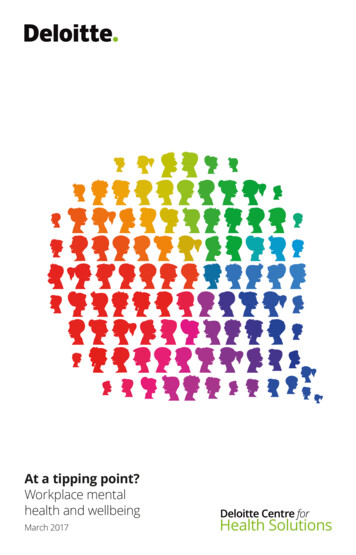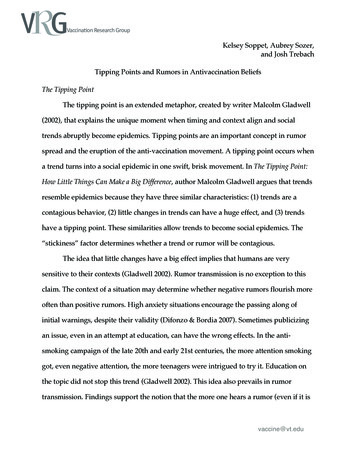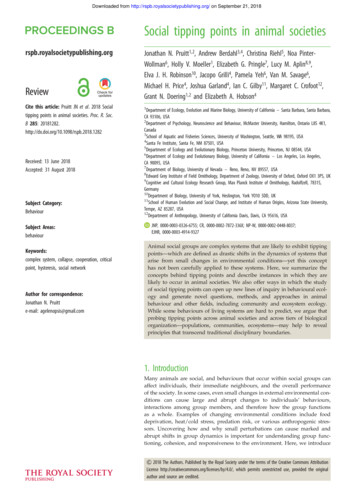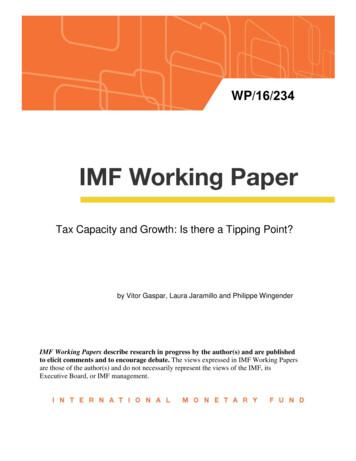
Transcription
At a tipping point?Workplace mentalhealth and wellbeingMarch 2017
ContentsForeword 01Introductory letter 02Executive Summary 03The importance of mental healthand wellbeing in the workforce 04The trends driving interest in workplacemental health and wellbeing 10Challenges in improving workplacemental health and wellbeing 14Collective actions for stakeholders 20Endnotes 28Contacts 32The Deloitte Centre for Health SolutionsThe Deloitte UK Centre for Health Solutions is the research arm of Deloitte LLP’shealthcare and life sciences practices. Our goal is to identify emerging trends,challenges, opportunities and examples of good practice, based on primary andsecondary research and rigorous analysis.The Centre's team of researchers seeks to be a trusted source of relevant, timely, andreliable insights that encourage collaboration across the health value chain, connectingthe public and private sectors, health providers and purchasers, patients and suppliers.Our aim is to bring you unique perspectives to support you in the role you play indriving better health outcomes, sustaining a strong health economy and enhancing thereputation of our industry. In this publication, references to Deloitte are references toDeloitte LLP, the UK member firm of DTTL.
At a tipping point? Workplace mental health and wellbeingForewordWelcome to Deloitte’s report: At a tipping point? Workplace mental healthand wellbeing.Public awareness of the importance of good workplace mental health and wellbeing is growing, as is the moral,societal and business case for improving it. Yet, despite this, many employers experience numerous challengesin improving their performance in supporting employee mental health and wellbeing. Our report is designedas a call to action for employers, whatever their current position, as well as a practical guide on how to addresssome of the main barriers to improvement.A number of recent developments are helping to raise the profile of these important issues, including thepublication of Business in the Community’s National Employee Mental Wellbeing Survey and Mental Healthtoolkit for employers in late 2016; the Prime Minister’s January 2017 announcement of an independent report oncompanies’ actions to support mental health; and Mind’s first Workplace Wellbeing Index.The impetus for this report was The insight we gained in working with one of our charity partners, themental health charity Mind, and its Workplace Wellbeing team. Further insights were provided by workingon a number of key projects on both mental and physical health in the workplace; including projects withoccupational and corporate health providers over the past five years. This experience has given us a broadand differentiated perspective on the importance of workplace mental health and wellbeing. Interviews withemployers undertaken over a number of years suggest that employer and employee attitudes to mental healthare changing. We believe we are on the cusp of a change similar to that seen with the corporate responsibilitymovement in the mid-1990s when momentum gathered pace, such that by the early 2000s corporateresponsibility reporting had become mainstream.This report presents our views on: the importance of mental health in the workplace the changing environment for workplace wellbeing the challenges in implementation and in changing employer and employee attitudes solutions to current and future challenges.We hope that you find the research insights informative, thought-provoking and of practical help for employersseeking to play a greater role in supporting the mental health and wellbeing of their employees.As always we welcome your feedback and comments.Karen TaylorDirector, Centre for Health SolutionsElizabeth HampsonSenior Manager, Monitor Deloitte01
At a tipping point? Workplace mental health and wellbeingIntroductory letterEmma Mamo, Head of Workplace Wellbeing, MindOver the past few years, employee wellbeing has been rising up the agenda for employers in the UK. A keyaspect of this is the mental health of staff. Organisations depend on having a healthy and productive workforce:we know that when employees feel their work is meaningful and they are valued and supported, they tend tohave higher wellbeing levels, be more committed to the organisation’s goals and perform better. We appreciatethe work that Deloitte has done to support Mind and other organisations to promote this agenda includingproducing this report.I joined Mind in 2007 and have led our campaigning for mentally healthy workplaces since 2010. Over the courseof our work we have seen an evolution in how employers view workplace wellbeing, with the focus shifting fromthe reactive management of sickness absence to a more proactive effort around employee engagement andpreventative initiatives. This shift has given employers the impetus to look at the mental health of their staff froma different perspective; with an increasing acknowledgement that they need to do more to support the mentalhealth of their staff.Despite these strides there’s still a long way to go. Mental health problems can affect anyone in any industryand yet mental health is often still a taboo subject. Our poll in 2014 revealed that a staggering 95 per cent ofpeople who have had to take time off due to workplace stress did not feel able to give their employer the realreason, and as the Time to Change Public Attitudes survey indicated in 2014, 49 per cent of people still feeluncomfortable talking to an employer about their mental health. There is clearly still work to do when it comesto breaking down stigma and providing the type of open and supportive culture that enables staff to be honestwith their manager, to access support and to enjoy a healthy working life.In seeking to move from rhetoric to reality employers must mainstream good mental health and make it a corebusiness priority. A mentally healthy workplace and increased employee engagement are interdependent – bylooking after employee’s mental wellbeing, staff morale and loyalty, innovation, productivity and profits will rise.In order to create a mentally healthy workplace, we recommend that employers put in place a comprehensivestrategy to help people stay well at work, to tackle the root causes of work‑related mental health problems andto support people who are experiencing a mental health problem. Many of the measures we recommend aresmall and inexpensive. Regular catch‑ups with managers, flexible working hours, promoting work/life balanceand encouraging peer support; can make a huge difference to all employees, whether or not they have a mentalhealth problem. But above all, creating a culture where staff feel able to talk openly about mental health at workis the most important part.At Mind, over the next five years, we want to support a million people to stay well and have good mental healthat work. To help achieve this, we have launched a Workplace Wellbeing Index which will enable employers tocelebrate the good work they’re doing to promote staff mental wellbeing and get the support they need to beable to do this even better. The Index is a benchmark of best policy and practice and will publicly rank employerson how effectively they are addressing staff mental wellbeing.Be part of the movement for change in workplace wellbeing by starting your journey towards better mentalhealth in your organisation today.02
At a tipping point? Workplace mental health and wellbeingExecutive SummaryMental health and wellbeing describes our mental state – how we are feeling and how well we can copewith day-to-day life. Promoting mental health and wellbeing in the workplace is important for employees,their employers, society and the economy. This is because poor mental health impacts individuals' overallhealth, their ability to work productively (if at all), their relationships with others, and societal costs related tounemployment, poor workplace productivity and health and social care.Employers have a key role to play in supporting employees' mental health and wellbeing. The government hasgiven increasing recognition to the importance of workplace mental health as have forward-looking employerswho are creating strategies around workplace mental wellbeing. This change in emphasis has been supportedby a number of trends, namely greater public awareness of mental health, increasing political interest in mentalhealth and greater transparency around corporate responsibility. In particular, over the past 25 years, policiesrelating to mental health have referenced the role of employers more explicitly and with increasing frequency.Our report identifies a number of actions for employers, employees and key stakeholders across society: For employers, it is important to raise the priority given to mental health and wellbeing in order to movetoward a culture which proactively manages mental wellbeing. This could be through the appointment ofhealth and wellbeing leads, or signing-up for corporate pledges. It is also important to take stock and monitorperformance using validated tools to track quantifiable measures and gain momentum and buy-in aroundwellbeing programmes. This can allow organisations to implement relevant initiatives, such as mental healthtraining for managers, and track and promote their success in line with other business metrics. For employees, it is important to become actively engaged in their own health and wellbeing and participate instrategies that promote both mental and physical wellbeing. This includes employee involvement in workplaceprogrammes around mental health, with potential actions including volunteering as a mental health championor making efforts to address stigma through sharing personal stories. Employees should also be made awareof the support available to colleagues and any strategies available to support employee mental wellbeing. More broadly, society and the state should encourage collaboration with corporate employers to improveworkplace mental health by investing in research and developing an improved evidence base, formingstrategic partnerships with other stakeholder to spread best practice, and supporting workplace wellbeinginitiatives such as the ‘Time to Change’ employer pledge and ‘This is Me’. Policymakers also need to focus onpolicies that provide aligned incentives to encourage companies to take charge of employees’ mental healthand promote actions that improve mental wellbeing.Currently, there are a number of promising developments in the workplace mental wellbeing space whichshould enable employers to better support employees, as well as to prioritise, quantify and track employeemental health and wellbeing. Whilst the speed at which workplace mental wellbeing strategies are successfullyimplemented may vary, we believe that we are reaching a tipping point in the priority now being given toaddressing mental health issues in the workplace and the roles and responsibilities of employers, a positivemove which has benefits for employees, employers and society.Despite these positive trends, we see a number of challenges for employers in successfully implementingworkplace mental health and wellbeing programmes. These include a failure to see employee mental health asa priority against other operational demands; a reactive approach to implementing mental wellbeing policiesrather than focussing on prevention; a lack of understanding around how the company currently performs inthis space; a poor evidence base to measure the return on investment of any programmes; and a lack of bestpractice examples to promote improvements. Workplace stigma and perceptions around mental health underlieand exacerbate many of these challenges.03
At a tipping point? Workplace mental health and wellbeingThe importance of mental health andwellbeing in the workforceIn any one year, over one in four peoplein the general population and one insix workers is likely to be suffering froma mental health condition. With over31 million people in work in the UK, thisis equivalent to over five million workerswho could be suffering from a mentalhealth condition each year.5, 6The UK has made significant progress in opening upconversations around mental health and wellbeingand in attempting to reduce the stigma it invokes.However, this progress appears to be occurringat a slower rate in the workplace, compared toconversations occurring in public spaces moregenerally. Reporting mental health issues in theworkplace is much lower than for other ill healthconditions due to reasons of stigma and a lack ofknowledge and training on how to support friends andcolleagues in the workplace.Yet, workplace mental health and wellbeing is asignificant issue which employers have a moral aswell as economic reason to address (see Figure 1).Employees who can take proactive measures tomanage their mental health and wellbeing, cangive their best at work. Poor mental health impactsemployees, their families, employers and the state.An acknowledgement of this economic impact isreflected in the increased focus on mental health inpolicymaking, especially the political commitmentsto achieve parity in treatment of mental and physicalhealth, and the increasing role of employers tosupport their employees’ mental health.While there are close links between mental andphysical health and wellbeing, this report focuses onmental health and wellbeing in the workplace, andthe need for dedicated strategies to be integrated inoverarching human resources (HR) and health andsafety policies. References to wellbeing in the reportare therefore to mental wellbeing (see sidebar forfurther definitions).04Definitions of mental health and wellbeingWellbeing is defined by the UK Departmentof Health as feeling good and functioning well,and comprises each individual’s experience oftheir life and a comparison of life circumstanceswith social norms and values. Wellbeing can beboth subjective and objective.1Mental wellbeing, as defined by Mind,describes your mental state. Mental wellbeingis dynamic. An individual can be of relativelygood mental wellbeing, despite the presenceof a mental illness. If you have good mentalwellbeing you are able to: feel relatively confident in yourself and havepositive self-esteem feel and express a range of emotions build and maintain good relationships withothers feel engaged with the world around you live and work productively cope with the stresses of daily life, includingwork-related stress adapt and manage in times of change anduncertainty.2Mental health is defined by the WHO, as a stateof mental and psychological wellbeing in whichevery individual realises his or her own potential,can cope with the normal stresses of life, canwork productively and fruitfully, and is able tomake a contribution to his or her community.Mental health is determined by a range ofsocioeconomic, biological and environmentalfactors.3Work-related stress, as defined by theWHO, is the response people may have whenpresented with demands and pressures thatare not matched to their abilities leading to aninability to cope, especially when employeesfeel they have little support from supervisorsas well as little control over work processes.4
At a tipping point? Workplace mental health and wellbeingFigure 1: Impact of mental ill health to employees, employers and societyTheimportance ofmental healthand wellbeingImpact onemployees In 2015-16 there were 488,000 reported cases of work-relatedstress, anxiety or depressioni 77 per cent of employees have experienced symptoms of poormental health in their livesii Mental ill health has negative impact on physical healthiiiImpact onemployers The total cost of mental ill health to UK employers wasestimated at 26 billion, costing 1,035 per employee, per yearin 2007iv Only 2 in 5 employees are working at peak performanceii Studies suggest that presenteeism from mental ill healthalone costs the UK economy 15.1 billion per annum, in what isalmost twice the business cost as actual absence from workivImpact onsociety Mental health (not specific to workplace wellbeing) costs the UK 70 billion each year, equivalent to 4.5 per cent of GDP v Mental health is a growing cause of incapacity benefitsvi Evidence shows that poor mental health increases the costs ofphysical ill healthiiiSources: (i) Health and Safety Executive, Work related stress, anxiety and depression statistics in Great Britain 2016, HSE, 2016; (ii) Mental health at Work Report 2016,Business in the Community, 2016; (iii) Bringing together physical and mental health, a new frontier for integrated care, The King’s Fund, 2016; (iv), Mental health atwork: developing the business case, Centre for Mental Health, 2007; (v) Mental health and work, OECD, 2014; (vi) Mental illness 'top reason to claim incapacity benefit‘,BBC news, 2011Impact on employeesThe average person spends 90,000 hours of theirlife working. Poor employee mental health can bedue to factors internal or external to the workplaceand, without effective management, can seriouslyimpact employees’ productivity, career prospects andwider health. While there is increasing awareness ofthe impacts of poor employee mental health, thereremains a disconnect between employers’ intentionsand perceptions and what is actually happening in theworkplace. This means that employees often do not getthe help they need to maintain a fulfilling and productiveworking life, and some line managers are frustrated bythe lack of support to do what they know is right. Thestrategies and statistics in this report are relevant toemployees who require support for pre-existing mentalhealth conditions, those who develop conditions dueto factors external to work, and those who experiencepoor mental health as a direct consequence of theirroles and workplace environment.In 2015-16, work-related stress accounted for 37 percent of all work-related ill health cases and 45 percent of all working days lost due to ill health.7 Thetotal number of working days lost due to work-relatedstress, anxiety and depression was 9.9 million days, anaverage of 24 days lost per case.8 However, accordingto data from Mind, 95 per cent of employees who havetaken off time due to stress named another reason,such as an upset stomach or headache.9 The MentalHealth at Work Report 2016, based on the Business inthe Community’s National Employee Mental Wellbeingsurvey, provides an up-to-date and comprehensiveassessment of workplace mental health in the UK.Participants took part via a YouGov panel survey(3,036 respondents) and a public open survey(16,246 respondents). Figure 2 highlights the mainfindings from the survey.10, 1105
At a tipping point? Workplace mental health and wellbeingFigure 2: Findings from the National Employee Mental Wellbeing survey84% of employeeshave experiencedphysical,psychological,or behaviouralsymptoms of poormental healthwhere work was acontributing factor35% of employees didnot approach anyonefor support on themost recent occasionthey experiencedpoor mental health86% would thinktwice before offeringto help a colleaguewhose mentalhealth they wereconcerned about9% of employeeswho experiencedsymptoms of poormental healthexperienceddisciplinary action,up to and includingdismissalSource: Mental health at Work Report 2016, Business in the Community, 201606Whilst 60% of boardmembers and seniormanagers believetheir organisationsupports people withmental health issues,only 11% discusseda mental healthproblem with theirline manager76% of line managersbelieve employeewellbeing is theirresponsibility22% have received someform of training onmental health at work49% would find evenbasic training incommon mental healthconditions usefulIn the case of astaff member withdepression:68% of femalemanagers would feelconfident respondingto the issue, comparedto 58% of malemanagers76%22%49%68%58%
At a tipping point? Workplace mental health and wellbeingLow levels of employee wellbeing negatively impactproductivity, but more importantly have a significantnegative impact on employees’ overall health. A 2015report based on a meta-analysis of 228 researchstudies on the topic found a link between causes ofworkplace stress and health outcomes:However, absence is not the only cost associated withpoor mental health. Other costs include: job insecurity increases the odds of reporting poorhealth by about 50 per cent turnover costs, which is the cost of replacing staffwho leave their job due to a mental health problem. high job demands raise the odds of having aphysician-diagnosed illness by 35 per centGiven this complexity, total business costs of mentalill health are difficult to define. To date, figures from a2007 Centre for Mental Health report are those mostconsistently cited by organisations such as Mind, theAdvisory, Conciliation and Arbitration Service (Acas),Business in the Community and the UK Government.The report calculated that mental ill health at workcosts UK businesses 26 billion. Later analysis raisedthis to 30 billion.19 The split was estimated at around10 per cent due to the cost of replacing staff, 30 percent cost due to sickness absence, and 60 per centcost due to reduced productivity at work. The reportfurther suggests that improving the management ofmental health in the workplace, including preventionand early identification of problems could enableemployers to save 30 per cent or more of thesecosts.20 long work hours increase mortality by almost20 per cent.12Stigma is another challenge facing employeessuffering from ill mental health, especially if there islittle understanding of mental health in the workplace.Whilst general public awareness and acceptance ofmental health has increased, the workplace has beenslow to follow suit. For example, 48 per cent of peoplewith mental health problems said they would not becomfortable talking to their employer and only 55 percent of employees believe their manager is concernedabout their wellbeing.13, 14Finally, the personal cost of mental illness is extensive,from loss of income and debt, (one in four adults withmental health problems are in debt), to wider familychallenges.15 A study by the Centre for Social Justiceacknowledges that family breakdown is both a causeand effect of poor mental health.16 Family relationshipchallenges may become further exacerbated whereloss of income occurs as a result of poor mental healthof a primary breadwinner.Impact on employersWhile the underlying causes of mental illness arecomplex and multifaceted, pre-existing mental healthconditions, new conditions related to changes in anindividual’s personal situation and the consequencesof work-related deterioration of mental wellbeingamong staff create significant costs for employers.The financial cost of poor mental health to employersis most easily illustrated through the sickness absenceof employees, as discussed above.17 presenteeism, which is the loss in productivity thatoccurs when employees come to work but functionat less than full capacity because of ill healthNevertheless, while improving support for employeeswith a pre-existing condition or those suffering aperiod of mental ill health is crucial, recognising thatwe all have varying states of mental wellbeing at alltimes is equally important. There is an additionalcost to employers that results from staff not beingengaged and enthusiastic, which extends wider thanpresenteeism. Acknowledging this allows for effectivepreventative actions that both the individuals and thebusiness can implement to keep more employees inthe top quartile of wellbeing for longer.However, the lack of precision around measuring thecost of mental health to employers also impacts onthe ability to measure savings and benefits accruingfrom workplace wellbeing programmes. The lack ofclear return of investment (ROI) benefits for preventionprogrammes has been a key challenge to wideradoption of good practice interventions and initiatives.This is a topic we will explore later in this report.07
At a tipping point? Workplace mental health and wellbeingImpact on societyPoor mental wellbeing is also costly to society. Thisincludes the costs to the public sector and strains onthe National Health Service (NHS).Costs to the public sector include disability benefits,as those suffering from mental health problemsare also more likely to be unable to work. In 2015,48 per cent of Employment and Support Allowancerecipients had a mental or behavioural disorder astheir primary condition.21Overall costs of poor mental wellbeing to the NHSinclude a disproportionate use of NHS services as acomplication from under-managed mental health, anddeterioration of individuals’ physical health linked withpoor mental wellbeing. Evidence from a 2016 King’sFund study indicates that: poor physical health contributes greatly to areduced life expectancy of 15 to 20 years of peoplewith severe mental illnesses against the generalpopulation depression and anxiety disorders lead tosignificantly poorer outcomes among people withdiabetes, cardiovascular disease and other longterm conditions (LTCs) 12 to 18 per cent of all NHS expenditure on LTCs islinked to poor mental health and wellbeing – between 8 billion and 13 billion in England each year people with mental health problems use significantlymore unplanned hospital care for physical healthneeds than the general population, showing a3.6-fold higher rate of potentially avoidableemergency admissions.22In 2014, NHS England published the Five Year ForwardView to set out a new shared vision for the future ofthe NHS based around new models of care.23 Twoyears later, in 2016, a separate document entitledthe Five Year Forward View for Mental Health waspublished by the Mental Health Taskforce, with theaim of improving mental health outcomes across thehealth and care system.08Part of the analysis within this report shows thesignificant link between physical and mentalhealthcare costs and the corresponding impact onstate health and social care spending. For example,physical healthcare costs for people with type 2diabetes with poor mental health are 50 per centhigher than for those diabetes patients in good mentalhealth, resulting from increased rates of avoidablehospital admissions and complications in this group.In total, the presence of poor mental health isestimated to be responsible for 1.8 billion of spendon the type 2 diabetes pathway.24In 2014, the OECD conducted a report on mentalhealth and work in the UK, estimating a total cost of 70 billion.25 The economic and social cost breakdownof these overall costs is likely to be in line with a similarstudy carried out in 2009-10 by the Centre forMental Health: 50 per cent human costs, based on a valuation ofthe negative impact of mental health on sufferers’quality of life 30 per cent cost of output losses due to reducedability to work 20 per cent direct health and social care costs.26
At a tipping point? Workplace mental health and wellbeingFigure 3: Costs of mental ill health to the NHS1 in 3 people with longterm physical conditionsalso experience mentalhealth problems, increasingtreatment costs by around 8-13bn a year.iHalf of terminally ill oradvanced cancer patientssuffer from depression,anxiety, and/or anadjustment disorder, yet lessthan 50% receive treatmentfor their mental health.iDepressed co-morbidpatients are three timesmore likely to be noncompliant with treatmentrecommendations than nondepressed patients.i1 in 10 people wait over ayear for access to talkingtherapies.iCosts for physical healthcarefor people with type 2diabetes who have poormental health are 50%higher than for diabetespatients in good mentalhealth.iiImproving mental healthoutcomes requires aminimum investment of 1 billion in 2020/21 inmental health services.iiiSource: (i) A call to action: achieving parity of esteem; transformative ideas for commissioners, NHS England, 2014; (ii) The Five Year Forward View, NHS England, 2014;(iii) The Five Year Forward View for Mental Health, NHS England, 2016The above analysis indicates clearly that poor mentalhealth and wellbeing at work is a significant and urgentchallenge. It is important not only to individuals and theirfamilies, but there are also significant incentives for allemployers and the state to act. In subsequent chapterswe explore: the trends driving an interest in workplace mentalhealth and wellbeing (Part 2) the challenges of implementing workplace mentalhealth and wellbeing initiatives (Part 3) collective actions for stakeholders to address theidentified challenges (Part 4).09
At a tipping point? Workplace mental health and wellbeingThe trends driving interest in workplacemental health and wellbeingPublic interest in workplace wellbeing in general, and mental wellbeing inparticular, has grown significantly in recent years.Greater public awareness of mental healthLevels of interest and awareness around mentalhealth have increased over the last ten years, drivenby high-profile public media campaigns such as Timeto Change, the emergence of new employer-drivennetworks and alliances to support those sufferingfrom poor mental health, and high-profile mediastories about personal experiences with mental health(Figure 4).27This part of the report explores the reasons for thisincreased interest including: greater public awareness of mental health increasing political attention and associated policychanges workplace trends and increased emphasis onemployer responsibilities.Figure 4: Trends supporting greater public awareness of mental healthWell-advertised campaignsTime to Change wasfounded by the mentalhealth charities Mind andRethink Mental Illness in2007. It receives fundingfrom the Department ofHealth, Comic Relief and theBig Lottery Fund to end thestigma and discriminationthat people with mentalhealth problems face.Networks and alliancesIn rece
Welcome to Deloitte's report: At a tipping point? Workplace mental health and wellbeing. Public awareness of the importance of good workplace mental health and wellbeing is growing, as is the moral, societal and business case for improving it. Yet, despite this, many employers experience numerous challenges










